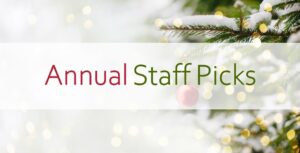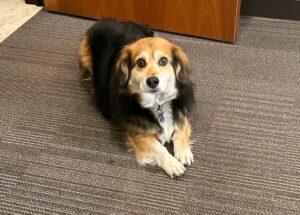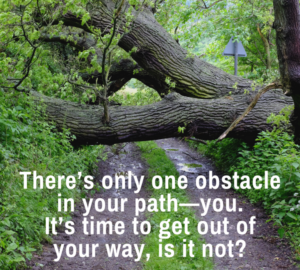Leapsolutions | December 22, 2023

It is time for Leap Solutions’ annual “Staff Picks”; our wishes, recommendations, and commitments to you—our loyal clients, associates, and friends—for making 2024 a year of inspiration and growth!

In this issue of our newsletter:
- Office Dog
- For Such a Time as This
- Let the Gingerbread Games Begin!
- What Else is Possible?
- A Case for Discomfort
- The Sound of Silence
- Digital Mindset
- My Mentors
- Get Out of the Way… Your Own Way

OFFICE DOG
Although my dog used to occasionally visit the office, in 2023, he has become a regular fixture as the office boy. His partner in crime had a stroke in late 2022, so I started bringing him along with me off and on. I would hear about it from the Leap team when I didn’t bring him, and what was an occasional visit turned into an everyday excursion. He has his routine from sleeping in one office or another to getting treats from the team and delivery people, and he even attends meetings in the conference room whenever he wants. He watches the door and gets excited or barks depending on who is coming in. I even have the luxury of leaving him here all day if I am away at client sites and the team keeps a watchful eye on him, or maybe it’s the other way around.
He is embraced by his teammates at Leap, which I would have never thought possible. Having a dog in the office is interesting, and sometimes, it takes a village to help when needed. The team will take him outside, take him for quick walks and he is excited every day to get in the car and take that ride to the office. He’s not yet billing any hours, but he gives love and affection to the team, which is good enough.
Not every office allows pets, but my boss allowed me to test it out and so far, so good! Thanks, Boss Man and Bolindre, for coming to work with me every day!
Wishing everyone a Happy Holiday Season.
Chuck McPherson
Partner
FOR SUCH A TIME AS THIS
I have a vivid memory of when I was a very little girl sitting in my mom’s lap as she read the story of Esther to my brother and me. It was Christmas time, and there were Christmas cookies stacked high on every flat surface in the dining room and kitchen in preparation for the church Christmas Bazar. My brother and I were each clutching one of these cookies in our chubby little hands as Mom read the story.
Every year, when I make Christmas cookies from mom’s recipe, this memory flashes back through my mind’s eye. I can see the old house, I can smell the nutmeg, I can taste the sweet buttery warmth of the cookie, and I can hear mom’s voice reading from the story, “Perhaps you were born for such a time as this.” I turn this verse over and over in my mind every time I think of it. I believe that whatever my circumstances, my “for such a time as this” is right now, right here.
Each of us has been put on this earth at this time, in this place, and with these people for a reason, just as Esther was. In the story, the beautiful Queen Esther, orphaned as a child, had been raised by her cousin Mordecai. Esther was chosen by the powerful (and impulsive) King Xerxes to be his queen. Mordecai told Esther not to reveal her ethnicity to Xerxes, but when the fate of Jews under the reign of Xerxes was threatened, Mordecai knew Esther might be able to get the king to change his mind. Esther was courageous and stood for what was right even though she might have lost her position or even her life by doing so.
We will probably never encounter a moment as pivotal as the one Esther did. However, those simple words “for such a time as this” inspire us toward what we all long for: our chance to make a difference. What I have found is those moments come when I least expect them; they come in the midst of the humdrum, the hardships, and everything in between.
This Season, I encourage you to pause and reflect on how you can make a difference. What is your “for such a time as this”?
Jonna Dye
Senior Human Resources and Organizational Development Consultant
LET THE GINGERBREAD GAMES BEGIN!
According to tradition, decorating gingerbread houses started in Germany in the early 1800s. Certain researchers claim that the first gingerbread houses were the result of the well-known Grimm’s fairy tale “Hansel and Gretel,” in which the two children abandoned in the forest found an edible house made of bread with sugar decorations.Gingerbread house competitions are a real thing in our household! Since my two girls were little, we have been putting together houses, and yes, I am one of THOSE moms who go to the ends of the Earth looking for the perfect candy to decorate.
My kids are adults now, and things in the gingerbread world have really changed since they were little. Now I “Google” “Best Gingerbread House Candy,” scope out ideas for candy online, and am able to buy in bulk. One of my favorite things is you can buy pre-fab houses that look more like mansions, so the day can be spent decorating rather than trying to keep the house from collapsing all day from the weight of the candy. We have also discovered that hot glue guns really come in handy and help the process move along faster. This has been a real game-changer for us!
And to bump up the stakes, we have added a theme to our decorating. Last year, it was a movie theme. My oldest decided to go with the house from The Shining – complete with blood oozing out and down the windows, while I chose a more fairytale, traditional theme of Hansel & Gretel!
It is never too late to start this tradition. I highly recommend it, as it has brought so much joy, laughter, and fun into our home.
Wishing you a wonderfully blessed, happy, and healthy Holiday Season and New Year!
Jen Chelini
Executive Search Consultant

WHAT ELSE IS POSSIBLE?
An older sister introduced this phrase to me. Or should I say reintroduced. It took her some time to get me to start using it because Miss Know-It-All did not always get my attention growing up. She was always telling me one thing or another and my automatic response was What does she want? Little did I know she was giving me a gift.Today I catch myself thinking or saying this out loud to almost everything that crosses my path.
“No, I can’t do that.” What else is possible?
“I don’t have time.” What else is possible?
“I don’t have the resources.” What else is possible?
“There is no money.” What else is possible?
Many of us just shut down or give up the minute we hear a negative statement. Asking yourself or the person you are interacting with, “What else is possible?” gives a little pause and can get your creative juices flowing.
The biggest benefit to adding this question to my daily living is not being afraid to ask questions because no matter what the answer is you are opening windows and doors to more possibilities.
So, go out, live life with less fear and ask yourself – What else is possible?
Rosa Reynoza
Human Resources Associate
A CASE FOR DISCOMFORT
I grew up in Sonoma County, but like many, I only experienced select portions. We were mainly a lake family and a local park family. We would take the boat to Lake Mendocino every summer, ride bikes around Rohnert Park, and eat lunch at the nearby park on Sundays. All beautiful and wonderful memories that I would never change, but it wasn’t until adulthood that Sonoma County opened up to me even more. What I knew of our outdoors was only a tiny fraction of what surrounds us.
Even though the 76 miles of Sonoma County coastline is a short 30 minutes away, more or less, my experience of the beach the few times I went in my first 20 years of life was wind and cold. Pretty? Yes. But I could not get over the wind slapping my face and never seemed to be dressed correctly. Then, I married into a beach family. We camp at the beach several times a year, and now, my husband and I take our children to the coast almost every weekend. What changed? My mentality, my preparation. I would not be caught dead in jeans at the beach unless it is an unusually warm forecast. And even then, I wouldn’t trust it. My formula for the perfect beach outfit is layer after layer. Sure, that’s a given, but there is a reason my husband asks, “How many pairs of pants this time?” when we get in the car. If you’ve seen the show Friends, think of Joey shuffling around in Chandler’s entire wardrobe. That’s me at the beach. But I am warm and happy and prepared for any temperature Bodega can throw at me. As a reward for bundling up, I get to experience the most beautiful sunsets I have ever seen, explore the tidepools with my kids, and ground myself after a busy week.
The series of hiking trails around Sonoma County held the same discomfort. I recall feeling winded and my legs burning as we climbed. It wasn’t until I started my fitness journey that I learned that discomfort is worth the reward of feeling better and learning that I am capable of the climb. Once I put in the work to build my strength and stamina, a whole new Sonoma County world opened up to me. The trails are never-ending, winding through redwoods, on bluffs looking down on the coastline, alongside vineyards, and up mountains overlooking our fields and wildlife. Views I never would have seen if I had remained in my bubble of comfort.
What am I trying to share with you? That you should visit Sonoma County, say hi to us at Leap, and take in all the outdoors has to offer? Well, definitely, but not exactly. This version of Sonoma County that I may sound like I am trying to sell you on (have you booked your flight to Sonoma County Airport yet?) is not one I came to know until I was open to leaving my creature comforts behind and experiencing some discomfort along the way. Many of us are creatures of habit. Routines are comforting, and we like what we like. But on the other side of initial discomfort is- surprise, more comfort! In new and different experiences and locations.
Get to know the landscape of your city, your county, and your state. It may surprise you what more surrounds you that you didn’t even realize. Experience some discomfort, adapt, and find something beautiful in your own backyard.
Heidi Ower
Office Administrator
THE SOUND OF SILENCE
On a beautiful morning in early May this year, I stepped into my bathroom to take a shower, turned on the fan, and heard nothing. I spoke out loud, “Hello, hello, hello,” and heard nothing. I turned on the shower and heard nothing. The nothingness was deafening.
I lost the hearing in my right ear probably 35 years ago. It started off feeling like my ear was plugged. The hearing loss continued over several years until I couldn’t hear anything but very loud noises. No one could explain the loss. Then I got vertigo, which started affecting my ability to walk and drive. I received an injection in my ear to kill the remaining hair cells, which made me completely deaf in that ear, but the vertigo was gone!
About two years ago, I experienced a sudden loss in my one good left ear of about 25%. Devastated, I was fitted for a hearing aid, and life moved on until that fateful May morning.
Life being deaf is very isolating. It instills fear and anxiety, and it’s frustrating for both parties to try and communicate, which negatively affects relationships. Accessibility apps have a long way to go to make communication better.
Thankfully, there are artificial devices called cochlear implants that can simulate hearing, and in August, after three months of isolation, I had surgery to get one. Amazingly, my audiologist encouraged me to get my implant in my right side, the ear where I had been deaf for 35 years! After a week of recovery, the processor was turned on, and to my astonishment, I could hear sound! Even more astonishing, I could comprehend some sounds as being words! This is not typical so soon after an implant, and especially from a dead ear, so my expectations were exceeded by miles. With continued rehab, I should be able to hear to my full potential within 12 months of that surgery.
I appreciate all of our clients who have worked to accommodate me through this process by doing Zoom calls with closed captioning instead of phone calls, and I especially want to thank the Leap team for their love and support by accommodating my surgery and recovery absence, accommodating a schedule change from full- to part-time, taking on a heavier workload, and for making me feel included when I felt so all alone. Cheers to an incredible team, and a happy Leap Year to all!
Tracy Long
Senior Human Resources Consultant
DIGITAL MINDSET
Having worked in the healthcare industry for several years, I witnessed firsthand the introduction and importance of AI. Our future is moving forward; AI is changing the landscape of healthcare, along with many businesses. The potential for AI is huge. It has the ability to apply problem-solving techniques that humans cannot do alone. From everything I hear and read, AI shows no signs of slowing down.
In the healthcare arena, I saw several advantages: the ability to analyze data in real-time, which improves diagnoses, and wearable technology is improving the health of many with chronic illnesses.
As in healthcare, AI will play a crucial role in businesses. We have already witnessed many examples and may even have them in our own homes and offices: smartphones, digital assistants, smart speakers, and smart TVs, to name a few. PCs have evolved to recognize many languages and images. Booking your next flight, AI decides the cost of the flight and, once in the airport, your gate selection. AI systems even help support the pilots on the flight. Self-driving cars, facial recognition, translation of language texts, the list goes on.
Even though AI is still in its early stages, we are beginning to recognize what is possible. How can we prepare our business or organization? AI plays a critical role in business by enhancing efficiency, automating tasks, and providing data-driven insights. It can be used in areas like customer service, data analysis, and improving decision-making.
Navigating the future and embracing AI
In a rapidly evolving technological landscape, it is becoming a necessity that we integrate AI into business operations. How can you adopt AI in your business:
- Educate Stakeholders: Provide a comprehensive education and clarify any misconceptions about AI.
- Identify Business goals: Clearly define goals and aim to achieve them using AI.
- Assess Readiness: Assess your organization’s current technological infrastructure and your overall readiness for AI implementation.
- Start with Small Pilots: Encourage a phased approach to AI implementation. Allow your business to test the waters, learn from initial experiences, and then gradually scale up AI initiatives.
- Collaborate with AI Experts: Whether through a partnership, hiring, or consultancy, having a well-versed professional will accelerate the learning and implementation.
- Address Workforce Concerns: AI is a tool used to augment human capabilities, not replace jobs.
- Ensure Ethical Practices: Be transparent, accountable, and responsible for AI practices.
- Seamless Integration into Existing Systems: Monitor, regularly assess performance, and gather feedback.
Following these ideas should help your business navigate the complexities of AI adoption, using its potential to drive innovation, efficiency, and growth, moving into a digital mindset for 2024.
How do you think the integration of AI will impact your business operations and overall strategy?
Harvard Business Review article: Reskilling in the age of AI; September 2023
Judy Coffey
Senior Consultant, Leadership Coach, and Mentor
MY MENTORS
Shortly after starting my career in Human Resources, I met someone who inspired me to go to college to get my degree because I wanted to be just like her when I grew up. She had her PHD! She was smart, kind, warm, and made it look so easy when she got up and spoke in front of people. She inspired me to keep learning and to be genuine in my interactions with colleagues and employees.
After 34 years in Human Resources, I have a new mentor. She has done amazing things in her career and now she spends her time teaching others to be the best they can be, volunteering, and going on a lot of vacations! I want to do that when I grow up! My advice to my younger self (and my children) – Save for your retirement! If your company offers a 401(k) with a company match, put enough into your account each payroll to get the full company match. Every time you get a raise, put at least half the raise into the 401(k) until you have reached your annual maximum amount. We somehow learn to live on whatever that net pay amount is, so put it in the 401(k) before you ever see it.
Be happy in all you do! Life is too short not to be fabulous!
Happy Holidays!
Tracy Emmerich
Senior Human Resources Consultant
GET OUT OF THE WAY… YOUR OWN WAY
While coaching a client not long ago, I listened to their story with fascination. They spoke about how little was making sense, how frustrated they were, their uncertainty in a new leadership peer relationship, and the pressure to make significant decisions. I was intrigued.
As Brene Brown has shared in her book, “Dare to Lead,” I was listening to the coachee’s “Shitty (or Stormy) First Draft” (SFD). Brene describes the SFD as a story we tell ourselves about whatever is going on with us. It can be about a specific situation, someone in our life (work or personal), a circumstance, something said to us, or even a series of these occurrences over a period of time. The SFD is produced in our mind based on our interpretation of this event. In most cases, the SFD is not very accurate and tends to exaggerate our fears, insecurities, and/or shame.
In the conversation with my coachee, I asked how the SFD was informing their current state and their strong reaction during a 3:1 with their boss and peer leader. I wondered aloud with them if their SFD narrative was “getting in their own way?” We had come full circle in the discussion as the question hit a major chord for them. We had recently discussed how they coached one of their direct reports to “get out of their own way.” Their advice was coming home to roost with their current situation.
The SFD was keeping them from connecting the dots. It inhibited their ability to sort through what was not making sense or allowing them to feel safe in a key work relationship. It was their attempt to fill in the missing pieces of the story they were telling themselves, but unfortunately, in the moment, it only fed their feelings of fear, anger, and/or pain.
Realizing they were getting in their own way, we stepped back together to dive deep into the situation and dissect the true story they were telling themselves, not the SFD. As we progressed in the discussion, the coachee brightened up, and a clear solution and path emerged. When we wrapped up, the SFD was gone, and in its place, the coachee was set to speak with their colleagues and work closely to address the situation. They were getting out of their own way—away from their SFD.
We have all created a SFD and allowed the story to get in our own way. Unfortunately, our brain is lacking some key pieces of data and, via the SFD, fills in the missing pieces based on past experiences. Essentially, the brain creates its own story, its SFD. While we can believe the SFD at the moment, its impact influences our actions. We build a solution to create the “happily ever after ending” that, deep down, we know will not work for us. We allow the SFD to get in our own way and not create a viable solution for ourselves. Our negative beliefs about ourselves or past life experiences inform the SFD. This is how we get in our own way.
When the SFD is identified, get out of your way by building the second draft improved through introspection, clarity, conversation, and learning from what has not worked for you. From my varied coaching experiences, raising the question about how the coachee is getting in their own way helps reveal the SFD and move them to the improved second draft.
Scott Ormerod
Partner

*****
Leap Solutions is a diverse group of highly skilled management, organizational development, and human resources, and executive search and recruitment professionals who have spent decades doing what we feel passionate about helping you feel passionate about what you do. Our HR specialists can help you get a handle on the ever-changing COVID-19 guidelines, programs, and legislation that may impact you and your employees. We are available to work with you to develop practical solutions and smart planning decisions for your organization’s immediate, near, and long-term needs.
To print this article, Click Here


Leapsolutions | July 7, 2023
Leadership
By Scott Ormerod & Chuck McPherson

A couple of years ago, Alice was identified as a potential leader as part of the nonprofit succession plan. Alice was a program coordinator for the agency serving families. Besides knowing the job very well, Alice always volunteered for additional projects such as the strategic planning committee, the parent committee, or the development of a new program funded by the State. She demonstrated enthusiasm, was a learner, and was driven to serve the organization. When the Program Director, Linda, spoke with Alice about her personal development plan, she discovered that Alice had a lot of ambition and a desire to grow into a leadership role within the agency. What Linda discovered was that the organization had not developed or implemented a leadership development program. Succession planning was even new to the organization. They called Leap Solutions and asked for our help to identify the best practice options for a leadership development program.
As a business management consulting firm, we engage with clients about leadership, what it is, how it shows up within an organization’s culture, and how it is developed. Simply put, leadership is the action of leading a group of people or an organization. Leadership can also be defined by the ability of an individual or a group of people to influence and guide followers or members of an organization, society, or team. Leadership is an attribute tied to a person’s title, seniority, or ranking in a hierarchy (either perceived or real). But do these descriptors really identify what it really is? Absolutely not. How does one even get to be called a leader? Perhaps the perception is that he/she is “a natural born leader” or they develop into becoming a leader, one with high potential. Either way, leadership development is ongoing. Let’s explore these two concepts.

A natural-born leader emerges by seizing opportunities to develop and strengthen their leadership capabilities through challenges, experience, and learning as they engage, explore, and develop their leadership traits. They naturally have leadership capabilities, which they strengthen along their continuous journey. A high-potential, emerging leader builds their capabilities by seizing opportunities focused on self-learning, mentoring, coaching, and experiential leadership tools. While not naturally showing leadership capabilities, their journey continuously builds skills through knowledge, experience, and a willingness to make and learn from their mistakes.
If you desire to build and grow natural-born and high-potential leaders, what is available for this journey? First, identify the desired leadership skills and competencies within the organization and match the needs with identified natural or high-potential emerging leaders. Leadership growth can be achieved formally through training and specific development tools or informally through experiences such as project assignments that stretch their skills.

One of our clients engaged with us to create and implement a leadership development program. Together, we created a multi-year leadership program with an annual cohort of new leaders to participate in a program of coaching and leadership development. Their strategy is developing a deep field of both natural and high-potential emerging leaders. Participants benefit from past program participants while the whole organization benefits from a succession of leadership learners applying their skills. Essentially, the participants are earning their MBA in Leadership internally. The program results impact not only leadership but the bottom line through stronger client relationships, new business opportunities, and a growing network of potential clients. In reality, a small investment is yielding significant results.
To create a strong leadership program, participants benefit from formal and informal training and development activities achieved through various tools and experiences such as:
Mentorship – Internal mentors are critical for all team members as well as creating a leadership development environment. This allows for a multi-level approach to identify mentors at all levels of the organization. The mentor/mentee relationship can be formalized to ensure a meaningful and transformational experience. It supports learning from one another by understanding needed skills, core attributes, and experiences for planned growth. When focused on leadership development, the relationship can evolve around the type of leader the mentee aspires to emulate and what attributes they possess that makes them a leader to admire and understand.
Coaching – Formalizing the development process into a coaching relationship moves the experience from learning from others through relationships and observation to learning of one’s self and identifying development goals. Working with a coach to understand themselves, leads to real-life experiences and learning with a strong balance of introspection. Digging deep allows the coachee to grow and gain leadership skills. The key is setting development goals and holding the coachee accountable for reaching their goals.
Planning and Executing – Being conscious of development opportunities through planning creates the platform for executing. You have to know where you want to head in order to create a plan to get there. Making a conscious effort to plan, set goals, hold yourself accountable, and achieve plan execution sets the path for leadership development and success. A planning leader is able to clearly state the direction he/she is heading and bring others along to achieve the plan.
Leadership Assessments – The world is full of leadership assessments that identify behavioral traits (the foundation of leadership skill identification and utilization), profile strengths (and opportunities), and leadership potential. Pick one or a few to paint the leadership picture. The assessments are valuable as a foundation of what exists and point out the potential and opportunities for leadership development. The more a leader understands themselves, the stronger they will understand others. If you can explore what it might be like to walk in another leader’s shoes, the greater opportunity to understand their profile and what you might want to incorporate or develop within your skill set.
Values and Attributes – Leadership values are anchors or foundations of what makes a leader tick. They create the platform that keeps the leader on point for what is important to them. Along with their key leadership attributes, team members actively understand how they show up, what they can count on, and how they will respond when problems need solutions. Their words and actions are in harmony, and the walk is the talk. Alignment provides consistency of leadership and the ability for others to follow.
Education – The formal aspect of learning has many paths for the developing leader. Masters programs in leadership, certification programs, seminars, and leadership development programs are all potential learning paths.

Informal leadership development happens each day in a growing, learning organization that fosters active participation in skills development through individual experience and experimental learning. A culture that supports informal leadership development encourages taking risks, learning from mistakes, and taking the initiative to grow. In other words, the culture embraces initiative and provides opportunities to match enthusiasm with potential.
We once had a team member who thanked us for allowing them to earn their MBA on the job. We created an environment of formal and informal leadership development that allowed the team member to identify their potential and attain their goal of strengthening their knowledge and actively applying it while serving our clients. It was a win-win strategy of leadership development.
The world is changing, but it still needs great leadership to survive and thrive. Each organization has its own inherent opportunities and can set the culture it desires to develop its leaders. If you are wondering if you have a culture of leadership development, reach out to us and let’s have a conversation.

Are You Ready to Leap?
***
Leap Solutions is a diverse group of highly skilled management, organizational development, and human resources, and executive search and recruitment professionals who have spent decades doing what we feel passionate about helping you feel passionate about what you do. Our HR specialists can help you get a handle on the ever-changing COVID-19 guidelines, programs, and legislation that may impact you and your employees. We are available to work with you to develop practical solutions and smart planning decisions for your organization’s immediate, near, and long-term needs.
To print this article, Click Here


Leapsolutions | October 3, 2022

The Leap Team loves a good book or two or ten. If you peeked at our book purchases, you’ll see the diversity of our interests. We figured our newsletter readers would like to see what we have been reading and using in our work with our clients. Enjoy this year’s Team Leap Book Club selections! Reading a book is a good thing to do and with the ability to read, listen and sometimes even watch a book or story on stage or on a screen, it is time to make your next selection. Here are some of ours…
Books reviewed in this issue of our newsletter:
- The Imperfect Board Member
- The Heart Led Leader
- Personal and Executive Coaching-The Complete Guide for Mental Health Professionals
- Blink: The Power of Thinking Without Thinking
- The 7 Habits of Highly Effective People: Powerful Lessons in Personal Change
- No Ego
- The AAA Way to Fundraising Success

By Jim Brown
Publisher: Jossey-Bass
ISBN-10: 0787986100
By Chuck McPherson ~ This book provided a rather quick and easy read while providing some key insights for Board Members. CEO’s, Executive Directors and Management could also have valuable takeaways. Through his story telling, Jim Brown outlined clear roles and responsibilities using the terminology of a straight line meaning that each has clear reporting relationships and “end arounds” need to be managed. Most board cultures are developed by fault and not by design which is why it is common to have the 80/20 rule whereas 20% of the board does most of the work. The whole board needs to be informed before key strategic decisions are made and the have-to-have time to process the information. He suggests that information go out to the board well in advance of the meeting for time to read and process because board members are very busy with their business life outside of the board they sit on. There were a few key elements, but I want to be careful not to give it all away since I am suggesting this to be a future read of yours.
To Direct and Protect, the board must:
- Connect- Get to know each other’s strengths, biases, etc.
- Expect- Have a shared understanding about what directors and the board are expected to do
- Correct- Deal with breaches of expectations to keep board performance high
- Boards do not ask for or accept recommendations. A recommendation is a decision in disguise
- Boards do however ask for options with pros and cons so they can make informed decisions
- Make time for the whole board to be properly informed
- Consider a one-page progress at a glance report
There are many more little nuggets in this book that can help support an old, seasoned board member or a person who is new to a board. The best boards work together as a team, capitalizing on the strengths that each director brings to the table and demanding full engagement.

By Tommy Spaulding
Publisher: Currency
ISBN-10:055341903X
By Jen Chelini ~ New York Times Bestselling author Tommy Spaulding, a world-renowned leadership speaker spotlights how leading with your heart and focusing on looking inward can transform your life in his Heart Led Leader: How Living and Leading from the Heart Will Change Your Organization and Your Life.
More remarkable than degrees on a wall or a title behind your name – it’s our values and principles that guide our lives and shape our ability to lead others. Authentic leaders live and lead from the heart.
Drawing on qualities such as humility, vulnerability, transparency, empathy, and love we can effect true transformational change. What do these qualities mean? Spaulding speaks to those – and in addition, opens one’s eyes to the 18-inch journey from your head to your heart rather than from the space between your head and your mouth! Spaulding’s book is full of inspirational stories that illustrate heart-led leadership and how it can bring real change in oneself and touch the lives of others.

By Jeffrey E. Auerbach, PhD.
Publisher: Executive College Press
ISBN-10: 0970683405
By Tracy Emmerich ~ Personal and Executive Coaching – the Complete Guide for Mental health Professionals may be a good book for anyone considering or just beginning a career coaching people. Although therapy and coaching may use similar skills, coaching is a process of helping people achieve personal or professional goals or helping with performance or developmental goals.
The first part of the book is geared toward licensed therapists transitioning to coaching. Thereafter the book gives a step-by-step process for coaching clients, including case examples, which are great stories showing the processes and techniques in real-life scenarios.
My favorite chapter in the book was on Emotional Intelligence and Coaching. How many times have we had an employee who just seems oblivious to the feedback they are given, making us wonder if we are being direct enough? Dr. Auerbach provides some great coaching suggestions and techniques. One technique I seem to use a lot when managing conflict is to encourage my client to see the other person’s perspective and to focus on the behavior or the issue, not the person.
I have often been called a therapist by friends, co-workers, and some clients, but after reading the book, I understand and embrace my role as a coach. “Aid your clients in learning to work with people to find win-win solutions, when possible,” a motto I have lived by for much of my HR career. This book would be beneficial for anyone wanting to get into executive coaching but also has some good tips and reminders for anyone already in the field.

By Malcolm Gladwell
Publisher: Back Bay Books
ISBN-10: 0316010665
By Jonna Dye ~ Blink explains what happens when you listen to your gut feelings, why these snap judgments are often more efficient than conscious deliberation, and how to avoid your intuition leading you into wrong assumptions. Different professions and disciplines often have a term to describe the gift of reading deeply into the narrowest slivers of experience. Author Malcolm Gladwell writes that in the military, brilliant generals are said to possess “coup d’ oeil” meaning “the power of the glance”, which is the ability to immediately see and make sense of a battlefield. Napoleon had coup d’ oeil, so did Patton. In Blink, Gladwell refers to this rapid cognition as “thin-slicing” and explains how it works in everyday life. Often having a little information about a situation is enough to come to a correct conclusion.
Gladwell presents the “locked door” idea, which suggests while people are good at making snap judgments, they are also bad at explaining why they can make them. The key idea is explained as sometimes what is stated as desirable is not always what we find desirable. Gladwell goes into detail describing speed dating cases where people had listed specific traits they were looking for in potential partners but ended up being attracted to someone who didn’t have those traits. There are subtle environmental triggers that we aren’t aware of which can lead us to these snap judgments.
There are also negative effects of thin-slicing, for example, the Warren Harding error. This is when we make unconscious assumptions about someone and continue to cling to these assumptions even when presented with evidence to the contrary. Millions of Americans voted for the attractive 29th U.S. President based on his good looks; however, he turned out to be one of the worst presidents in history. Gladwell calls the Warren Harding error “the dark side of cognition” and states that it is a major cause of prejudice. However, he reveals that people can detect the Warren Harding error and make efforts to make unbiased decisions.
Blink illustrates how thin-slicing can be useful for making effective decisions. Such as when rapid cognition is used during auditions in classical music orchestras, which eliminates such factors as age, gender, race, and appearance, from the decision-making process. Gladwell describes blind auditions in the National Symphony Orchestra which resulted an increase of female musicians. Gladwell states that some people look like they perform better, while others look awful when they play despite sounding wonderful. Blind auditions take distracting factors out of the thin-slicing and allow only ears to judge.
Blink is an interesting read and can help us understand when thin-slicing is useful and when analytical thinking should be relied on instead.
By Stephen R. Covey
Publisher: Simon and Schuster
ISBN 1982137274
By Rosa Reynoza ~ There is so much you can learn from this book both in your personal and professional life. As a person who is involved with so many organizations, I want to make sure that my time is spent being as productive as possible. Part of my success is connecting with people and I always thought my listening skills were very strong, but this book took me to another level.
“Most people do not listen with the intent to understand; they listen with the intent to reply.” ~ Stephen R. Covey
I was very drawn to the way he describes deep listening. Deep listening really is powerful. It is one of the biggest tools we have to really connect to a person and really hear what they are asking for.
Another great topic was on perception. How you see or perceive a situation will make a huge difference in the way you react to that situation and feel about it.

By Cy Wakeman
Publisher: St. Martin’s Press, New York, NY
ISBN: 9781250144065
By Tracy Long ~ Cy Wakeman is a bestselling author, keynote speaker, and consultant and is well known in the Human Resource world for her Reality-Based Leadership. As a drama researcher, she helps organizations eliminate emotional waste in the form of workplace drama and infuse it with fact-based accountability.
No Ego is about how ego-driven emotions highjack our thought processes and cost organizations billions of dollars annually in lost productivity, reduced motivation, and low morale. These unproductive behaviors take the form of gossip, blame, dealing with hurt feelings, resistance to change, defensiveness, lack of buy-in, lack of ownership / accountability, and projecting made up stories instead of focusing on facts.
I found Cy engaging my ego when she pointed out that HR has been sold a bill of goods when it comes to employee engagement. HR professionals have long touted (from other researchers) that employees leave managers. Cy believes that this thinking makes employees passive and victims of circumstance rather than learning lessons about how to work with people they find challenging. While managers may not be responsible for work-place happiness, I think they can be responsible for workplace unhappiness.
NO EGO CORE BELIEF
Your circumstances are not the reason you can’t succeed;
they are the reality in which you must succeed.
Regarding her thoughts/research on engagement surveys, I thought she made a sound argument for limiting participation to those employees who were accountable. Why would we not want feedback on how to improve the business from those that contribute to customer satisfaction, improve processes, and solve problems rather than from those who are not meeting expectations, yet demanding more flexible hours and more paid time off?
Additionally, engagement surveys that focus on employee satisfaction rather than accountability might get you highly engaged, low accountable employees who will not sustain your business. Accountability must be a core value and disengagement is not an option.
NO EGO CORE BELIEF
Engagement without accountability creates entitlement
Rather than focusing on dated Change Management philosophies (which she thinks should die since they are out-of-place for the pace of change we live in now), Cy embraces Business Readiness. Instead of minimizing the disruption of change for workers, she has adopted a mind-set (pyramid) which changes the focus and the goals to awareness, willingness, advocacy, active participation, and driver. Ego by-passing questions such as, “How do you intend to step up and help get this done?”, are designed for self-reflection as opposed to reaction in a shared responsibility between employees and leadership. This is not to say that leaders don’t have responsibilities. By having transparency and clear expectations/deliverables, employees become partners with leaders in change instead of victims.
NO EGO CORE BELIEF
Change is hard only for the unready
Lastly, the book provides a Reality-Based Leadership Ego Bypass Toolkit in the appendix. One of my favorite self-reflection questions from the toolkit is, “If you didn’t have the story you’re telling yourself right now, who would you be?” Checkmate.

By Kay Sprinkle Grace
Publisher: Whit Press
ISBN-10: 0972020594
By Judy Coffey ~ Being involved in several Non-profit Boards, I see firsthand how many board members desire to be engaged with their non-profit’s programs and progress. However, many find it challenging to fundraise. The AAA book by Kay Sprinkel Grace is a tool to help boards understand how to transform into a “fundraising force”.
In this book, the author explains, if boards feel empowered and engaged in the fundraising program, they will become motivated and confident. The AAA program of fundraising has three vital components; the Ambassador, the Advocate and the Asker. Each role offers the board member an opportunity in fundraising and philanthropy. Most board members are motivated to “serve “and be involved. The AAA approach offers board members the opportunity to choose which role is best for them.
The Ambassador: This is a role each board member needs to play; it is critical to cultivating prospective donors. The Ambassador should be informed of the non-profit’s mission and vision, make friends, and create and nurture relationships. This role is one of cultivating generous philanthropists. This stewardship helps make it easier for the Askers to do their job.
The Advocates: This is often a more formal role; the information they share is more strategic. They are advocates for the organization; they make the case and share the “why” of the non-profit. These individuals are engaged with the strategic plan, and are confident in the non-profit’s success. As an Advocate, the individual can get quickly to the message and negotiate partnerships. They can increase broader recognition of the organization.
The Asker: This role is straight forward; they all enjoy asking; they are well informed and often are matched with like-minded individuals. They are good listeners and are very confident that the philanthropy dollars given are used and invested in the non-profit’s overall mission. The Asker will need to be prepared to answer the hard questions.
Some key innovation principles, according to AAA fundraising success:
- People give because the organization meets needs
- A gift is really for the community
- Fundraising is about shared values
Grace’s book is a great management tool which can support stable current and growing boards. It makes a board member’s role a bit easier when it comes to building relationships, understanding financial resources, and building confidence in their outreach.
Organizations cannot go it alone. Communities and the public benefit sector can together identify opportunities, problem solve, and in partnership their board can create a very successful non-profit to enhance the community they serve. The AAA Way to Fundraising Success maps out a way to work together to accomplish this task.

***
Leap Solutions is a diverse group of highly skilled management, organizational development, and human resources, and executive search and recruitment professionals who have spent decades doing what we feel passionate about helping you feel passionate about what you do. Our HR specialists can help you get a handle on the ever-changing COVID-19 guidelines, programs, and legislation that may impact you and your employees. We are available to work with you to develop practical solutions and smart planning decisions for your organization’s immediate, near, and long-term needs.
To print this article, click here


Scott Ormerod | October 31, 2019
At Leap Solutions, we see your limitless potential, and we know you can achieve the kind of leadership growth that directly translates to business success. But we won’t just tell you how; we’ll partner with you, empower you, and guide you through an executive coaching program that’s entirely tailored to you.
You’ll come away from your Leap coaching experience with vital tools for identifying and overcoming barriers, proven methods for meeting and exceeding meaningful objectives, and new and powerful interpersonal and management skills that will make your leadership more impactful and rewarding than ever before.
Coaching in Action
We’ll start with a thorough evaluation to gain a deep understanding of you as an individual and of your role within the organization. We’ll learn about your personality type and core behavioral traits, your leadership competencies, the particular demands of your position, and the culture and dynamics of your workplace. We’ll then ask probing questions that elicit invaluable introspection and self discovery, help you distinguish your perception of yourself as a leader from reality, and allow you to develop an exciting new vision for what’s possible as a leader.
Together with your coach, you’ll determine and address the root causes of specific problems or performance challenges; weigh options and walk through decisions; role play difficult situations and challenging employee relations; and translate your own life experiences to the workplace so you can manage from a place of authenticity and strength. We’ll set meaningful goals and put into place a realistic, workable action plan for reaching and surpassing them. We’ll tap into your driving personal motivations, equip you with all the knowledge, skills, tools and resources you need, and hold you accountable for the outcomes you want to achieve.
Your Leap coach serves as your confidante and cheerleader throughout the process, continually supporting, encouraging and strengthening you into the leader you aim to be while never losing sight of the direction and mission of your organization.
The Client-Coach Fit
Coaching is for new and seasoned leaders. It’s for anyone experiencing transition or facing a juncture or precipice. It’s for professionals looking to manifest their inner leaders or push themselves and their boundaries. It’s for everyone trying to flourish while balancing career, family, relationships and more.
What matters is that you’re open to progress and willing to work for it.
The ideal coach will inspire, inform and transform your leadership. Personality and style matter! Look for a coach who is engaging and insightful and who energizes you personally and professionally. You’ll want an expert you can trust with confidentiality concerns and with whom you’ll feel at ease opening up and exploring strengths as well as opportunities for improvement and growth. Your coach should be compassionate but direct, someone who connects with you but also challenges you and holds you accountable.
The Faces of Coaching at Leap
Leap Solutions coaches have decades of leadership development experience, but we each bring unique perspectives and strengths to the coaching process.
Judy Coffey, RN, MBA, Senior Consultant, Leadership Coach and Mentor
Over the past 25 years as a healthcare professional, Judy has coached and mentored experienced and emerging leaders across Northern California to enhance their skills in employee engagement, department management, effective communication, emotional intelligence and more. Judy is an exceptionally good listener and collaborator known for her ability to create a non-judgmental, safe and comfortable space for clients to expand their thinking, build on their confidence and explore and develop their own unique leadership style and approach. Responsive, flexible, fair and frank, Judy is genuinely interested and invested in the growth and advancing potential of each and every coaching client.
Chuck McPherson, Partner
For decades, Chuck has transformed teams of all sizes through organizational effectiveness, change management, strategic planning and professional development initiatives. He cultivates leaders through nontraditional planning processes, managing relationships, improving organizational behavior and driving organizational results. As an executive coach, Chuck is intuitive, direct and steadfast in his focus on what’s best for the individual and the business as a whole. Clients can count on Chuck to motivate them, support them and hold them accountable to making significant improvement and seeing immeasurable growth and success.
Scott Ormerod, Partner
Scott has more than 30 years of experience in people management, coaching, organizational development and human resources in a wide variety of industries including his passion for community service. His diverse background in business, healthcare, education and nonprofits makes him especially well suited for coaching executive leaders . He skillfully guides clients through obstacles and toward a leadership potential they never thought possible. Scott is committed to delivering on his clients’ return on investment by ensuring that his leadership development programs are fully transparent and that every executive coaching experience is wholly worthwhile and truly valuable to both the participant and the sponsoring organization.
Susana M. Morales, Organizational Development Consultant
Susana is a facilitator, evaluator and researcher and has worked extensively with nonprofits, state and local governmental agencies and universities in the Bay Area and beyond. A first-generation American, woman of color and native Spanish speaker, Susana coaches in both English and Spanish. She asks the right questions and provides effective tools and methods for coaching the whole person—who you are at work, at home and even when you are alone. Known for her energy and enthusiasm, patience and positivity, Susana helps develop clients into the highly capable, creative, resourceful leaders they are meant to be.
Whomever you choose as your partner, you can count on your Leap coach to build trust quickly and show you how to establish powerful, career-long strategies and systems for becoming your best leader.
What Are You Waiting For?
Leap Solutions believes wholeheartedly in the career-enhancing, life-changing value of coaching. We’ve coached countless leaders to find the clarity, skills and confidence to strengthen their roles and performance in their companies, achieve their highest goals and experience exponential growth in every aspect of their lives. Let us do the same for you!

Click here to print this newsletter
Scott Ormerod | August 30, 2019
Change isn’t just inevitable…it’s also vital to continued growth, success and prosperity.
Coaching can be a great way to ready yourself not only to accept change that comes your way but to embrace, influence and even drive change for the betterment of your organization and yourself.
When Change Hits
Often, change is thrust upon you—it’s not necessarily your idea and not necessarily welcome. But whether you’re facing an unanticipated change in employer, position, team, boss, peer, systems or processes, you can enlist a seasoned coach to help you:
- Overcome resistance. Many people have a natural tendency to resist change or get caught up in negativity and drama surrounding it. A coach will work with you to examine your resistance and separate known factors, truth and reality from perceptions, preconceived notions and fears.
- Take control. Your coach will pique your curiosity about what’s possible with impending change and show you that you are both in charge of and responsible for how you respond to it. Together, you’ll find ways to stay engaged and begin to address change from a place of strength, commitment and zeal.
- Stay accountable. You’ll learn just how much you can influence change when you are willing to lean into it and be proactive about it. Your coaching partner will challenge you to look for solutions and creative ways to make change work most effectively and successfully for you and your organization.
- See opportunity. Times of change are always times to consider what else might be doable. A quality coach will open your eyes to opportunity—maybe it’s the chance to retool a position to better serve your needs, reprioritize goals to reflect what’s truly important, save money or harness new technological advances. You’ll find that, with skilled coaching, guidance and support, change can lead to unexpected freedom and breakthrough.
- Serve as model. As you thrive through times of change, others will likely take notice and be inspired to join you. What will emerge is a communal spirit of cooperation, collaboration and progress that will surely push you all, as individuals and as an organization, toward a better future.
Driving Change
A great coaching partnership will empower you to cope confidently with even the most overwhelming of changes and move forward with intention, assuredness and positivity.
It will also motivate and equip you to envision and drive well-thought, well-managed change. Your coach will encourage you to:
- Be strategic. All too often, people make changes for the wrong reasons—perhaps they’re attracted to what’s shiny and new, they’re fearful that something unwanted might happen or they’re restless and choose to institute change for change’s sake. A coaching partner challenges you to think strategically about your intentions and works with you to determine whether you really need change as well as how best to go about implementing it.
- Strike a balance. The best kind of change achieves the ideal balance between doing things “the way we’ve always done them” and reinventing the wheel. Well-executed change honors the past and is based on a full understanding of what works (and what doesn’t), what’s already been tried (and what hasn’t) and how people are feeling about where things are and where they could be. It takes well-informed, calculated risks while acknowledging and celebrating the best of the old and reflecting and embracing the most promising of the new.
- Be thoughtful. Compassionate change leaders will recognize and appreciate how change impacts a company and its people. Stay particularly mindful of generational differences among employees that might affect reactions and approaches to change.
- Communicate well. Be transparent and straightforward about your reasoning behind any change, and be clear about your expectations. Make sure employees are comfortable voicing concerns, opinions and ideas and that you’re genuinely open to hearing them.
- Solicit buy-in. Support all parties to the best of your ability through change. Offer any resources they may need, including additional training, education, technology or tools for success.
- Recognize new possibilities. One change will often uncover another. Don’t be surprised, for instance, if a well-managed change spotlights a rock-star employee who simply didn’t have space and opportunity to shine before!
Flourishing Through Change
Sometimes change happens to you, and sometimes it’s well thought, well planned and well-executed. You need to be able to flourish through both. But even under the best of circumstances, change can be hard and often feels too fast and too furious.
The experts at Leap Solutions have decades of coaching experience, and we bring calm, clarity and efficiency to your change process. We also bring invaluable distance, outside perspective and insight while asking thoughtful questions, uncovering how change truly impacts you and everyone around you, challenging your thinking, and, together, imagining and realizing the incredible new opportunities that change can afford you and your organization.

Click here to print this newsletter!
https://leapsolutions.com/practice-areas/executive-coaching/
For further reading, check out: No Ego: How Leaders Can Cut the Cost of Workplace Drama, End Entitlement, and Drive Big Results by Cy Wakeman, St. Martin’ Press, 2017













![]()














